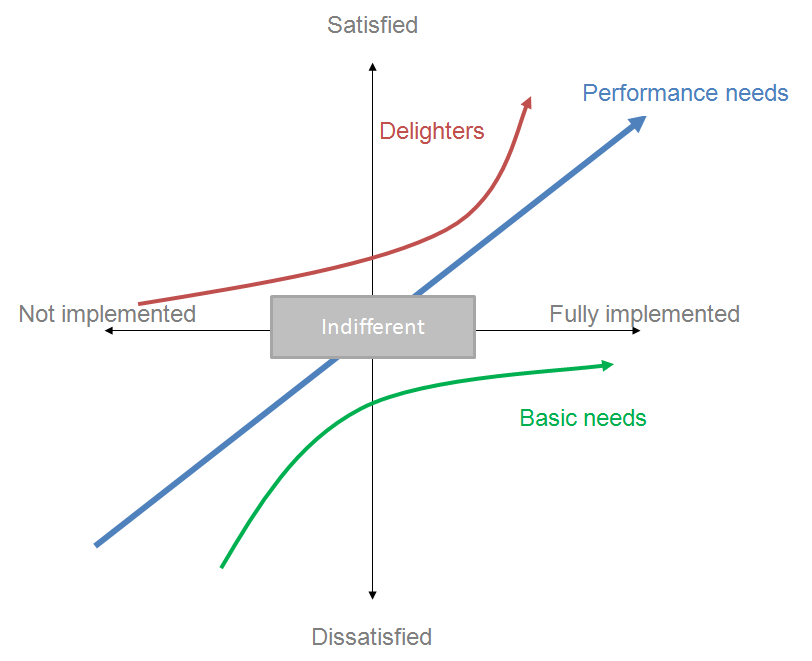
The threshold attributes are most often seen as a price of entry. Many products have threshold attributes that are overlooked. Since this component of the product is a necessary guideline, many consumers do not judge how advanced a particular fe
One of the main points of assessment in the Kano model is the threshold attributes. These are basically the features that the product must have in order to meet customer demands. If this attribute is overlooked, the product is completely incomplete. If a new product is not examined using the threshold aspects, it may not be possible to enter the market. This is the first and most important characteristic of the Kano model. The product is being manufactured for some type of consumer base, and therefore this must be a crucial part of product innovation. Threshold attributes are simple components to a product. However, if they are not available, the product will soon leave the market due to dissatisfaction. The attribute is either there or not. An example of a threshold attribute would be a steering wheel in a vehicle. The vehicle is no good if it is not able to be steered.
[ ] Threshold or Basic Attributes
(QFD) makes use of the Kano model in terms of the structuring of the matrices. Mixing Kano types in QFD matrices can lead to distortions in the customer weighting of product characteristics. For instance, mixing Must-Be product characteristicsпІп‚БЂ«such as cost, reliability, workmanship, safety, and technologies used in the productпІп‚БЂ«in the initial will usually result in completely filled rows and columns with high correlation values. Other techniques using additional matrices are used to avoid such issues. Kano's model provides the insights into the dynamics of customer preferences to understand these methodology dynamics.
The Kano model offers some insight into the product attributes which are to be important to customers. The purpose of the tool is to support product specification and discussion through better development of team understanding. Kano's model focuses on differentiating product features, as opposed to focusing initially on customer needs. Kano also produced a methodology for mapping consumer responses to questionnaires onto his model.
Venkitaraman and Jaworski (1993)
Satisfaction drivers terminology
These attributes refer to a high degree of achievement resulting in dissatisfaction and to the fact that not all customers are alike. For example, some customers prefer high-tech products, while others prefer the basic model of a product and will be dissatisfied if a product has too many extra features.
These attributes refer to aspects that are neither good nor bad, and they do not result in either customer satisfaction or customer dissatisfaction.
These attributes are taken for granted when fulfilled but result in dissatisfaction when not fulfilled. An example of this would be package of milk that leaks. Customers are dissatisfied when the package leaks, but when it does not leak the result is not increased customer satisfaction. Since customers expect these attributes and view them as basic, it is unlikely that they are going to tell the company about them when asked about quality attributes.
These attributes result in satisfaction when fulfilled and dissatisfaction when not fulfilled. These are attributes that are spoken of and ones which companies compete for. An example of this would be a milk package that is said to have ten percent more milk for the same price will result in customer satisfaction, but if it only contains six percent then the customer will feel misled and it will lead to dissatisfaction.
These attributes provide satisfaction when achieved fully, but do not cause dissatisfaction when not fulfilled. These are attributes that are not normally expected, For example, a thermometer on a package of milk showing the temperature of the milk. Since these types of attributes of quality unexpectedly delight customers, they are often unspoken.
These categories have been translated into English using various names (delighters/exciters, satisfiers, dissatisfiers, etc.), but all refer to the original articles written by Kano.
The Kano model is a theory of product development and developed in the 1980s by Professor which classifies customer preferences into five categories:
This article may require to meet Wikipedia's . No has been specified. Please help if you can. (November 2010)
From Wikipedia, the free encyclopedia
Kano model - Wikipedia, the free encyclopedia
Комментариев нет:
Отправить комментарий